Comprehensive Description
(
İngilizce
)
Memoirs of the American Entomological Society tarafından sağlandı
Anoplius (Pompilinus) splendens (Dreisbach)
Pompilinus splendens Dreiebach, 1949, Ent. Amer., (n.s.)29: 20-21 [Type: S, Kansas: Morton Co., 5 Aug. 1911 (FXW) (KU)].
Pompilinus pseudoreductus Dreisbach, 1949, ibid., pp. 21-23 [Type: Michigan: Muskegon, 6 Aug. 1945 (RRD) (MCZ, no. 29, 327)]. Synonymy by Evans, 1951. Pompilinus ohioensis Dreisbach, 1949, ibid., pp. 24-25 [Type: Ohio: Pickaway
Co., 21 June 1937 (RRD) (MCZ, no. 29, 326)]. Synonymy by
Evans, 1951. Anoplius {Pompilinus) splendens Evans, 1951, Trans. Amer. Ent. Soc, 76:
320-322. — Evans, 1956, Ann. Ent. Soc. Amer., 49: 117 (Mexican
records).
Female. — Length 7.5-14.5 mm. Black, first two abdominal tergites (rarely only the second) orange-brown; pubescence often silvery on parts of the head and thorax, sometimes wholly dark. Propodeum not at all hairy. Clypeus about 2.5 X as wide as high, truncate below. MID .51 -.56 X TFD; UID .80-.90 X LID; POL equal to or greater than OOL. Antennae slender, segment three at least as long as one and two together, equal to from .80 to 1.0 X UID; outer flagellar segments slender, all more than 3 X as long as thick. Tarsal comb short, as in the preceding two species. Slope of propodeum low and gradual, the declivity not strongly defined.
Male. — Length 6-11.5 mm. Black, with or without orange-brown coloration on some of basal abdominal segments; pubescence silvery over a considerable part of the head, thorax, and propodeum; propodeum without erect hairs. Clypeus about twice as broad as high; MID .54-.61 X TFD; UID subequal to or slightly less than LID; POL equal to or slightly greater than OOL. Third antennal segment 2.5-3.0 X as long as thick, about as long as fourth segment. Venter smooth, with only very short, scattered hairs. SGP rather broad, its median line strongly elevated, apically forming a small projection beyond the otherwise rounded margin of the plate. Genitalia with the parameres expanded and curved apically, the tip acute; digiti much as in the preceding species, but slightly broader and with the setae not so extensively angled at their apices (see figs. 30, 31, 53, 54 in Dreisbach, 1949; also figs. 103, 133 in Evans, 1951).
Distribution. — Florida, Texas, Durango, and Arizona to Idaho, Manitoba, Ontario, and Maine. Marginal U. S. records are given by Evans, 1951. (Map 58.)
Mexican specimens examined. — 2 5 9. Chihuahua: 1 ? , Carta Blanca, 16 mi. W Matachic, 8 July 1947 (WG) [AMNH]. Durango: 1 9 , 8 mi. S Canutillo, 9 Aug. 1951 (PDH) [CIS].
- bibliyografik atıf
- Evans, H.E. 1966. A Revision of the Mexican and Central American Spider Wasps of the Subfamily Pompilinae (Hymenoptera: Pompilidae). Memoirs of the American Entomological Society vol. 20. Philadelphia, USA

